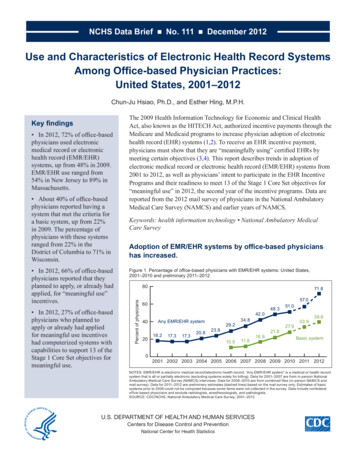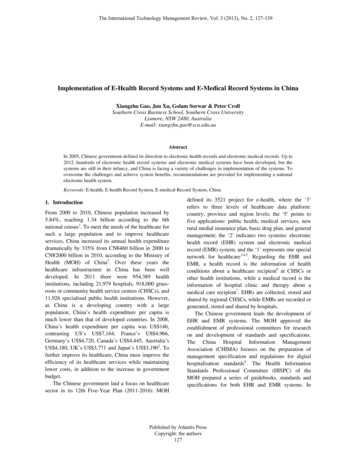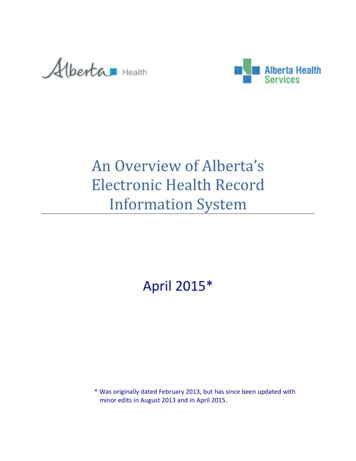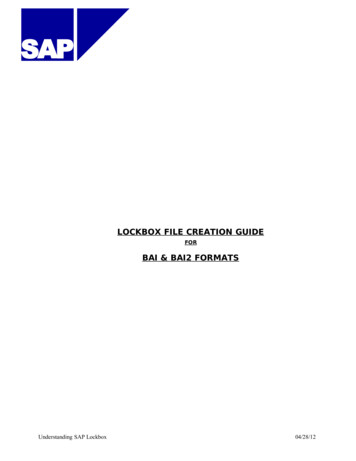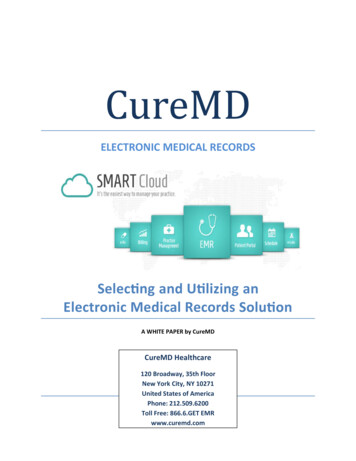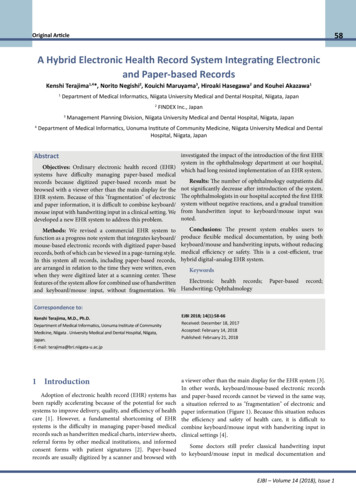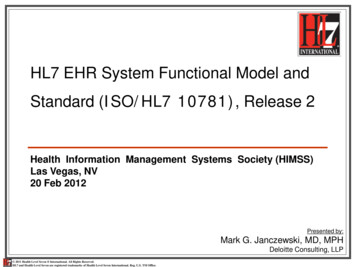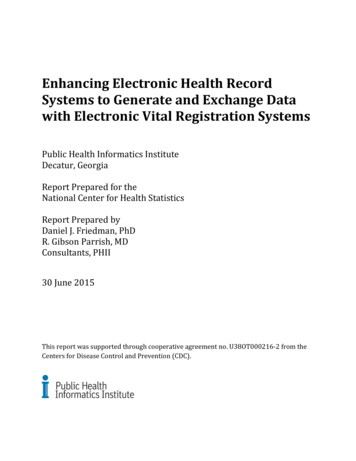
Transcription
Enhancing Electronic Health RecordSystems to Generate and Exchange Datawith Electronic Vital Registration SystemsPublic Health Informatics InstituteDecatur, GeorgiaReport Prepared for theNational Center for Health StatisticsReport Prepared byDaniel J. Friedman, PhDR. Gibson Parrish, MDConsultants, PHII30 June 2015This report was supported through cooperative agreement no. U38OT000216-2 from theCenters for Disease Control and Prevention (CDC).
Enhancing EHR-S to Generate and Exchange Data with EVRS30 June 2015Table of ContentsSummary3Project purpose8What did we do?Environmental scansInterviews8815What were three main things that we learned from our interviews?What’s the goal?Where’s the evidence?Where’s the market?16161617What else did we learn about perceived barriers, facilitators, and next steps for EHR-S/EVRScertification and EHR-S enhancements for EVRS?17What are the roadmap and routes to enhancing EHR-S to generate and exchange data withEVRS?Project development life cycle frameworkRelationship of project development life cycle framework to facilitatorsRoadmap and routesCertification and conformity assessment options2121222632How should specific routes be chosen for enhancing EHR-S to generate and exchange data withEVRS?35Births, fetal deaths, deaths35Criteria for choosing among routes35What is an appropriate framework for proceeding with certification or other conformityassessment options?36References38Appendix A. Materials reviewed for the project.39Appendix B. Major findings and recommendations from the Minnesota and Utah pilot projectson the use of EHR-S to obtain data for vital records43Appendix C. Organizational affiliations of experts interviewed for the project44Appendix D. Reported barriers to enhancing EHR-S to generate and exchange data with EVRS 45Appendix E. Reported facilitators for enhancing EHR-S to generate and exchange data with EVRS49Appendix F. Examples of Activities Required to Complete Different Routes for Enhancing EHR-Sto Generate and Exchange Data with EVRS54Appendix G. Figures used in reportPublic Health Informatics Institute55Page 2
Enhancing EHR-S to Generate and Exchange Data with EVRS30 June 2015SummaryProject purposeThe specific purpose of this project is to develop a roadmap with possible routes forcertification of electronic health record systems’ (EHR-S) capabilities for generating data forand exchanging data with electronic vital registration systems (EVRS). The more generalpurpose of this project is to develop a roadmap for enhancing EHR-S to generate and exchangedata with EVRS.What did we do?To provide context for the project, we reviewed publications, web sites, and unpublisheddocuments related to state and national vital registration systems, electronic health recordsystems (EHR-S), and certification programs for EHR-S. We also conducted telephoneinterviews with 42 experts, such as state health department vital records managers andinformaticians, health care providers and medical informaticians, certification experts, andEHR-S and EVRS vendors. Interview questions focused on potential barriers, facilitators, andnext steps to enhancing EHR-S to generate and exchange data with EVRS.What were three main things that we learned from our interviews?1. What’s the goal? Respondents typically pointed out that EHR-S/EVRS1 certification andenhancing EHR-S to generate and exchange data with EVRS should not be regarded as goals inand of themselves. Rather, we were told that the clearly stated goals for proceeding need to beimproving the quality2—that is, accuracy, completeness, and timeliness—of vital records data,delivered through state and national systems that are economical and efficient.2. Where’s the evidence? Respondents often viewed EHR-S/EVRS certification and EHR-Senhancements for generating and exchanging data with EVRS as hypotheses that need to bethoroughly tested through carefully planned and conducted pilot projects, rather than asalready proven assumptions.In this report “EHR-S/EVRS” refers to the ability of EHR and EVR systems to “communicate, exchange data, anduse the information that has been exchanged” in order to complete registration of births and deaths, andreporting of fetal deaths. In other words, EHR-S and EVRS exhibit interoperability. (HIMSS. Definition ofinteroperability [Internet], 2013. Available at: dards/whatis-interoperability.)2 In this report, we use quality as it applies to vital records to mean that those records and their data are accurateand complete and that the records are completed, processed, transmitted, and made available in a timely fashion.1Public Health Informatics InstitutePage 3
Enhancing EHR-S to Generate and Exchange Data with EVRS30 June 20153. Where’s the market? EHR-S vendors, hospitals, and state health departments (SHDs)3usually expressed little interest in EHR-S/EVRS certification and EHR-S enhancements forEVRS.What else did we learn about barriers and facilitators?Despite the three main findings from our interviews, our analyses of those interviews alsomade us realize that the barriers reported by respondents could usually be matched withfacilitators reported by themselves or other respondents. The barriers and facilitatorsmentioned by our 42 respondents relate to planning and stakeholder engagement; nationaland state policies; data quality; workflows; and health information technology. Frequentlymentioned facilitators included providing incentives for developing and implementing EHRS/EVRS; designing EHR-S/EVRS to minimize unstructured data; configuring EHR-S/EVRS tosupport quality improvement programs; developing a long-term plan for SHD implementationof HL7 messaging standards; and implementing EHR-S/EVRS pilot projects with plannedvariation and common metrics.What are the roadmap and routes to enhancing EHR-S to generate and exchange data withEVRS?Based on our environmental scan and interviews, we developed a roadmap with six potentialroutes for enhancing EHR-S to generate and exchange data with EVRS. We adapted the DHHSEnterprise Performance Life Cycle to serve as the framework for the roadmap and its sixroutes. See the figure 4 below. All routes start with stakeholder engagement and arequirements assessment and then diverge during the design phase of the Life Cycle. The sixroutes are:Route 1: Continue current vital registration (VR) processesRoute 2: Improve workflow for current VR processesRoute 3: Provide direct user access to the EVRS from the EHR-SRoute 4: Collect data for EVRS using third party applications that run within the EHR-SenvironmentRoute 5: Develop EHR-S module to collect and transmit VR dataRoute 6: Extract available VR data from EHR-S and complete form manually3In this report, state health departments (SHDs) refer to the 57 U.S. vital records jurisdictions.Public Health Informatics InstitutePage 4
Enhancing EHR-S to Generate and Exchange Data with EVRS30 June 2015What are the certification and conformity assessment options?Certification—a specific type of conformity assessment—is one potential tool among others toimprove system performance. During our interviews, EHR-S vendors stated that they wouldonly undertake certification of their systems for vital records functionality if such certificationwere mandated by state or federal government regulations or there were significant incentivesprovided for certification that made certification cost effective.Given the current lack of mandates and incentives for certification and assuming thatduring the requirements analysis there is support for some form of conformity assessment,two possible options should be considered:1. Including vital registration (a) as a public health registry under Stage 3 of meaningfuluse, or (b) in future editions of the Office of the National Coordinator for HealthInformation Technology’s (ONC) EHR certification criteria.2. Demonstrating a marketing advantage for vendors through a declaration ofconformity (DOC) for their EHR-S to the vital records requirements of the HL7 PublicHealth Functional Profile. A DOC would be much less costly and resource intensive thancertification and might be easier to justify to EHR-S vendors.How should specific routes be chosen for enhancing EHR-S to generate and exchange data withEVRS?Specific routes in the roadmap should be chosen using explicit criteria. These criteria include:whether to choose a route or routes for births, fetal deaths, or deaths, or any combination ofthese; maximizing quality—accuracy, completeness, and timeliness—and efficiency of vitalregistration systems; minimizing costs of design, development, testing, implementation,deployment and maintenance; maximizing speed of implementation and deployment;maximizing likelihood of SHD acceptance of a particular route; and maximizing the valueproposition for SHDs, data providers, and vendors.Public Health Informatics InstitutePage 5
Enhancing EHR-S to Generate and Exchange Data with EVRS30 June 2015What is an appropriate framework for proceeding with certification or other conformityassessment options?In proceeding with certification or other conformity assessment options, the followingconsiderations will need to be addressed: governance of certification or other conformityassessment, including establishment of criteria and measures; financing; laws, regulations, andpolicies; implementation; and compliance.Public Health Informatics InstitutePage 6
Enhancing Electronic Health RecordSystems to Generate and Exchange Datawith Electronic Vital Registration SystemsProject purposeThe specific purpose of this project is to develop a roadmap with possible routes forcertification of electronic health record systems’ (EHR-S) 4 capabilities for generating data forand exchanging data with electronic vital registration systems (EVRS), as specified in theHealth Level Seven International (HL7) EHR-System Public Health Functional Profile (PHFP)for birth, death, and fetal death reporting.5The more general purpose of this project is to develop a roadmap for enhancing EHR-Sto generate and exchange data with EVRS.What did we do?Environmental scansTo provide context for the project, we reviewed publications, web sites, and unpublisheddocuments related to state and national vital registration systems, electronic health recordsystems (EHR-S), and certification programs for EHR-S. Given the project’s focus on paths tocertification, we also reviewed examples of “roadmaps” developed by various healthorganizations.6Vital registration systemThe purpose of the U.S. vital registration system is twofold. First, the system legally registersbirths and deaths, records fetal deaths, and produces permanent legal records for selected lifeIn this report, EHR-S refers to hospital in-patient systems for births and fetal deaths, and to hospital in-patientsystems, nursing home systems, and ambulatory systems for deaths. Epic, Cerner (including Siemens), andMeditech currently dominate the in-patient EHR-S market.5 The HL7 EHR-System Public Health Functional Profile, Release 2 — U.S. Realm (March 2015) “identifiesfunctional requirements and conformance criteria for public health clinical information collection, managementand exchanges that include specific public health programs . . . This profile is a U.S. Realm Functional Profile thatarticulates the functional requirements needed to support data exchange among providers and public healthstakeholders including, but not limited to, states, local agencies, and federal agencies.” (HL7 2015).6 Appendix A lists the materials reviewed for the project, which should be consulted for a more detaileddescription of these topics.4
Enhancing EHR-S to Generate and Exchange Data with EVRS30 June 2015events, which are used for legal, financial, and other needs. Second, the system producesstatistical information about those life events, which are analyzed to provide informationabout population health. These different purposes impose distinct workflow requirements onvital records data providers and complicate efforts to enhance EHR-S to generate and exchangedata with EVRS.The vital registration system is complex. Vital registration in the United States is a staterather than a federal function, and the vital registration system is composed of 57 separateregistration jurisdictions.7 CDC’s National Center for Health Statistics periodically revises theU.S. standard certificates of live births and deaths, as well as accompanying data collection aidssuch as facility and mother’s worksheets.8 In order to obtain partial federal funding for theirvital registration systems through the Vital Statistics Cooperative Program (VSCP), states musttransmit birth, fetal death, and death data to NCHS in required data formats and meet dataquality standards. Individual states, however, may require vital records data providers—principally hospitals, physicians, medical examiners, and funeral directors—to collect dataadditional to those on the U.S. standard certificates, and collect the U.S. standard certificatedata in data formats that differ from those specified by NCHS. These state variationscomplicate efforts to enhance EHR-S to generate and exchange data with EVRS.The workflows used by hospital data providers for collecting birth certificate and fetaldeath data typically entail retrieval of data from prenatal care providers, the hospital birth log,medical records, and the mother.9 See Figure 1.10 Data from these sources are typicallycompiled by a birth clerk using facility and mother’s worksheets and then entered into anelectronic birth registration system (EBRS), which is managed by the state health department(SHD). Different vendors supply EBRS to SHDs in different states, as represented by “VendorA” and “Vendor B” in Figure 1. Some data for the birth certificate may be available from theThe 57 registration jurisdictions are the 50 U.S. states, the 5 U.S. territories, New York City and the District ofColumbia.8 The last major revision occurred in 2003. (NCHS 2003a, b, c) To facilitate the collection of more complete,accurate, and useful data through the certificates, NCHS develops and disseminates specifications for entering andediting data for specific items on the certificates. (NCHS 2012a, b, c) Companies that provide electronic vitalregistration systems to state health departments incorporate these specifications into their systems, althoughNCHS does not independently verify the availability of these specifications in EVR systems or the accuracy of datacollected by these EVR systems.9 See NAPHSIS, More Better Faster: Strategies for Improving the Timeliness of Vital Statistics. April, 2013.10 Full-page copies of all figures can be found in Appendix H.7Public Health Informatics InstitutePage 9
Enhancing EHR-S to Generate and Exchange Data with EVRS30 June 2015hospital’s electronic health record system (EHR-S).11 Multiple vendors supply hospitals andhealth care providers with EHR-S, as represented by “Vendor 1” and “Vendor 2” in the figure. Amajor EHR-S vendor often supplies multiple hospitals within a state, and hospitals in multiplestates. As a result, EHR-S vendors often have a multi-state and national perspective, ratherthan a single state perspective. We will discuss other aspects of Figure 1 later in the report.The workflow used by hospital, medical examiners, and funeral directors to retrievedeath data requires fewer data sources than for births and fetal deaths: at hospitals, certifyingphysicians and perhaps clerks retrieve and/or enter the needed data, and funeral directorsretrieve needed data from next-of-kin. Forty-four states have electronic death registrationSome hospitals refer to the EHR-S as an electronic medical record system (EMRS). We will use EHR-S in thisreport to represent both EHR-S and EMRS.11Public Health Informatics InstitutePage 10
Enhancing EHR-S to Generate and Exchange Data with EVRS30 June 2015systems (EDRS), but these states vary in the proportion of deaths registered through theirEDRS. For some deaths, no death data are collected through the EDRS, and these deaths arestill registered using paper certificates. For some other deaths, only part of the required data iscollected through the EDRS. EDRS data are transmitted to the SHD either before or afterlinkage of the medical data provided by the certifying physician or medical examiner with thedemographic and other data provided by the funeral director (see Figure 2). The complexitiesof these workflows and data retrieval processes, and the relatively greater complexity forbirths and fetal deaths than for deaths, complicate efforts to enhance EHR-S to generate andexchange data with EVRS.12In 2012, only 1.4% of U.S. births were out-of-hospital. (MacDorman MF, Mathews TJ, Declercq E. Trends in outof-hospital births in the United States, 1990–2012. NCHS data brief, no 144. Hyattsville, MD: National Center forHealth Statistics. 2014. Available at: ) In contrast, in 2012,62.0% of U.S. deaths were not in a hospital inpatient or outpatient setting (Centers for Disease Control andPrevention, National Center for Health Statistics. Underlying Cause of Death 1999-2013 on CDC WONDER OnlineDatabase [Internet]. Available at: http://wonder.cdc.gov/ucd-icd10.html; accessed 23 Jun 2015.)12Public Health Informatics InstitutePage 11
Enhancing EHR-S to Generate and Exchange Data with EVRSPublic Health Informatics Institute30 June 2015Page 12
Enhancing EHR-S to Generate and Exchange Data with EVRS30 June 2015Vital records standards for EHR-SNCHS works with standards development organizations, such as Health Level Seven (HL7) andIntegrating the Healthcare Enterprise (IHE), to incorporate the NCHS certificate data items andspecifications into national and international standards. For example, NCHS worked with HL7to develop the PHFP, which identifies functional requirements for clinical informationexchange among providers and public health stakeholders. (HL7 2015). NCHS also developedHL7 V2.5.1 Messaging, and Clinical Document Architecture (CDA) implementation guides (IGs)that have been published as draft standards for trial use (DSTU).13 IHE has developed andissued technical framework supplements for reporting births, fetal deaths, and deaths.14 Theycontain structured profiles based on HL7 standards and NCHS specifications to aidorganizations in building systems to “capture and communicate information needed to reportbirths and fetal deaths [and deaths] for vital registration purposes.” (IHE 2014). Nevertheless,the development and publication of standards does not ensure their use.EHR-S/EVRS pilot projectsNCHS funded two pilot projects to explore the use of EHR-S to obtain data for vital records. TheMinnesota Department of Health (MDH) worked with a hospital to analyze the workflow forgathering data for completing the birth certificate and whether needed data were availablefrom the EHR-S used by the hospital.15 The MDH project found that MDH and hospitals supportthe adoption of e-birth records standards but lack the readiness to fully test and implementthem: this important finding will be discussed further below.NCHS also funded a pilot project in Utah to assess the ability of physicians to providemore timely and higher quality data for death certificates to the Utah Department of Health byentering and submitting data via the hospital EHR. The project showed that using the EHRcould increase the number of unique ICD10 codes on death certificates. The greatest challengeThe messaging IG for vital records death reporting is available for comment until 11 August 2015; the CDA IGfor birth and fetal death reporting is available for comment until 13 February 2017 August 2015; and the CDA IGfor vital records death report is available for comment until 10 March 2017. All DTSUs are available at:http://www.hl7.org/dstucomments/.14 These supplements are the Birth and Fetal Death Reporting-Enhanced (BFDR-E) and the Vital Records DeathReporting (VRDR), which are available IHE QRPH Suppl BFDR-E.pdf /IHE QRPH Suppl VRDR.pdf, respectively.15 The Minnesota project also included participation by MDH staff in the 2013 and 2014 IHE Connectathons toexplore methods of extracting, packaging, and transmitting data from an EHR-S to the MCH.13Public Health Informatics InstitutePage 13
Enhancing EHR-S to Generate and Exchange Data with EVRS30 June 2015identified in the project was accurately matching and merging data received from hospitalphysicians via the EHR with data received from funeral directors via the health department’sEDRS.16 Additional findings and recommendations from the Minnesota and Utah pilot projectsare included in Appendix B.CertificationCertification is a specific type of conformity assessment, which is a process to demonstrate that“specified requirements relating to a product, process, system, person or body are fulfilled.”(ISO/IEC 2004) The distinguishing feature of certification as a type of conformity assessmentis its use of third party, independent testing and verification to ensure that the product,process, or system complies with previously identified criteria or specifications intended toreflect the ability of the process or product to serve its purpose. Certification is one potentialtool among others to improve system performance.With the passage of the Affordable Care Act (ACA) and its requirements for “meaningfuluse” (MU) and certification of EHR-S, the U.S. Department of Health and Human Services(USDHHS) developed a certification program for MU aspects of EHR-S. Figure 3 depicts thecurrent USDHHS MU certification program, which is managed by the Office of the NationalCoordinator for Health Information Technology (ONC).17,18The Utah project also identified the need for better infrastructure for reporting death from physicians to thehealth department; a significant impact of EHR use on the death certification workflow, especially for funeraldirectors; and the need for thorough testing of the system before introducing it into daily use.17 The first major effort to certify EHR-S in the United States was undertaken by the Certification Commission forHealth Information Technology (CCHIT). CCHIT developed a comprehensive, voluntary system for EHR-Scertification, which was designed to address both overall EHR-S infrastructure and specific content componentsand to become more stringent over time through the addition of more specific requirements.18 USDHHS released the third stage of MU requirements for public comment in March 2015. These MUrequirements include several ways that a health care organization or provider can provide MU of healthinformation, including the submission of data to public health and clinical care registries. (FR 2015)16Public Health Informatics InstitutePage 14
Enhancing EHR-S to Generate and Exchange Data with EVRS30 June 2015InterviewsTelephone interviews were conducted with 42 experts: 9 state health department (SHD) vitalrecords managers and informaticians, representing 5 separate SHDs; 9 health care providers, 2health care organization representatives, and 2 medical informaticians; 4 EHR-S and 3 EVRSvendor representatives; 6 certification experts; and 7 additional experts.19 Interviews wereloosely structured, with questions focusing on potential barriers to enhancing EHR-S togenerate and exchange data with EVRS, potential facilitators, and next steps. Theorganizational affiliations of the experts interviewed are listed in Appendix C.One consultant took the lead in asking questions for each interview, and the other consultant took the lead intaking notes. The note-taking consultant later summarized the notes, and the other consultant then reviewed andedited the notes.19Public Health Informatics InstitutePage 15
Enhancing EHR-S to Generate and Exchange Data with EVRS30 June 2015What were three main things that we learned from our interviews?What’s the goal?Respondents typically pointed out that certification of EHR-S capacities for generating data forand exchanging data with EVRS specifically, and enhancing EHR-S to generate and exchangedata with EVRS more generally, should not be regarded as goals in and of themselves. Rather,we were told the clearly stated goals for proceeding need to be improving the quality20—thatis, accuracy, completeness, and timeliness—of vital records data, delivered through state andnational systems that are economical and efficient.EHR-S/EVRS certification and EHR-S enhancements for generating and exchanging datawith EVRS were typically viewed by respondents as largely untested potential means toachieving the major goals of timely, accurate, and complete vital records data.Where’s the evidence?State health department respondents, health care providers, and informaticians oftenexpressed skepticism that EHR-S/EVRS certification specifically and EHR-S enhancements forgenerating and exchanging data with EVRS more generally would either: (a) necessarilyimprove vital registration workflows within hospitals, between hospitals or medical examinersand funeral directors, and between hospitals and SHDs; or (b) result in improved vital recordsquality together with improved efficiency and economy.Respondents often viewed EHR-S/EVRS certification and EHR-S enhancements forgenerating and exchanging data with EVRS as essentially hypotheses that need to bethoroughly tested, rather than as already proven assumptions. Similarly, respondents oftensuggested and emphasized the importance of carefully planned and executed pilot projects toempirically test both certification and EHR-S enhancements for EVRS. Finally, respondents alsopointed out that evidence relating to EHR-S/EVRS certification and EHR-S enhancements forEVRS needs to be considered separately for births and fetal deaths, on the one hand, anddeaths, on the other hand.In this report, we use quality as it applies to vital records to mean that those records and their data are accurateand complete and that the records are completed, processed, transmitted, and made available in a timely fashion.20Public Health Informatics InstitutePage 16
Enhancing EHR-S to Generate and Exchange Data with EVRS30 June 2015Where’s the market?EHR-S vendors, hospitals, and SHDs usually expressed little interest in EHR-S/EVRScertification and EHR-S enhancements for EVRS. EHR-S vendors pointed to the relatively smallmarket to support development and implementation of EHR-S enhancements for EVRS, the lowpriority given to vital records by hospitals, and the lack of interest in EHR-S enhancements forEVRS expressed by SHDs. Hospitals point to the low priority of vital records, compared to themuch higher hospital priorities of EHR-S enhancements for improving health care quality andpatient safety.21 SHDs point to the substantial investments that have already been made indeveloping and implementing EVRS for births and for deaths, the costs and uncertainties ofimplementing another major change in electronic systems, and the lack of federal or statefinancial support for developing and implementing EHR-S enhancements for EVRS.What else did we learn about perceived barriers, facilitators, and next steps for EHRS/EVRS certification and EHR-S enhancements for EVRS?The three main things that we learned from our interviews may appear to paint a bleak andunpromising picture for the future of EHR-S/EVRS certification and EHR-S enhancements forEVRS. However, when we analyzed our interviews and categorized what our respondents said,we realized that the barriers mentioned by respondents could usually be matched withfacilitators mentioned by themselves or other respondents.The barriers, facilitators, and next steps mentioned by respondents are catalogued inAppendix D (barriers) and Appendix E (facilitators and next steps). These tables are organizedby type of barrier, facilitator, or next step: general; planning and stakeholder engagement,including business case and marketing; national and state policies, including mandates andincentives, and state variability; data quality; workflows; health information technology,including EHR-S/EVRS design, EHR-S/EVRS implementation, and certification. In addition,Appendices D and E also indicate whether each barrier or facilitator affects data providers(hospitals or physicians), vendors (EHR-S or EVRS), and state health departments. The impactsof each barrier or facilitator are also described.One hospital-based health care provider emphasized the importance of high quality birth data to health careproviders, patients, hospitals, Centers for Medicare and Medicaid Services, and health departments, among others,for improving maternal and child health.21Public Health Informatics InstitutePage 17
Enhancing EHR-S to Generate and Exchange Data with EVRS30 June 2015In the following Table 1, we abstracted the most important reported barriers fromAppendix D and their matching reported facilitators from Appendix E. In the following Table 2,we summarized the most important reported barriers and reported facilitators separately fordata providers, vendors, and SHDs.Public Health Informatics InstitutePage 18
Enhancing EHR-S to Generate and Exchange Data with EVRS30 June 2015Table 1. Summary of major reported barriers and facilitators for improving the ability of EHR-Sto generate and exchange data with EVRS22TypeBarrierPlanning and stakeholder engagementPlanning-Systematic testing, development, andimplementation of EHR-S/EVRS23 requires longterm strategic planning and phasedimplementation over 10-15 yearsStakeholder-No customer interest in EHR-S/EVRSengagementBusiness case and -No empirical value case for EHR-S/EVRS, hencemarketingno financial return for investing in developmentNational and state policiesMandates and-Lack of financial incentives for developing andincentive
certification of electronic health record systems' (EHR-S) 4 capabilities for generating data for and exchanging data with electronic vital registration systems (EVRS), as specified in the . and ambulatory systems for deaths. Epic, Cerner (including Siemens), and Meditech currently dominate the in-patient EHR-S market. 5 The HL7 EHR-System .
